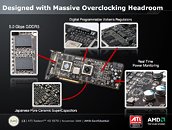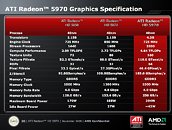Monday, November 16th 2009

Radeon HD 5970 Offers Massive Overclocking Headroom
AMD's dual-GPU flagship graphics accelerator, the Radeon HD 5970, is closer than you think it is. Slated for 18th Nov, it includes every feature that allows AMD to reclaim the performance leadership it yearned for since the beginning of this year. In a series of company slides sourced from XtremeSystems Forums, it is learned that this could be one of the first accelerators which AMD "openly" markets as having a "Massive Headroom" for overclocking. While the clock speeds on the HD 5970 are lower than those on the single-GPU HD 5870, AMD lifted limits on what the driver-level ATI Overdrive software can offer in terms of clock speeds. While the engine (core) and memory speeds are set at 720/1000 MHz, the unlocked ATI Overdrive lets users take the clock speeds all the way up to 1000/1500 MHz. That's 30% for the core, and a stellar 50% for the memory.
To back such speeds, AMD seems to have splurged heavily on top-notch components on the PCB. To begin with, the PCB holds two high-grade AMD Cypress GPUs, each with all its 1600 stream processors enabled. The GDDR5 memory, while clocked at 1000 MHz or 4 GT/s, is technically rated by its manufacturer to run at 1250 MHz or 5 GT/s. All systems are powered by high-grade digital PWM voltage regulators, with independent Volterra VRM controllers that allow real-time monitoring, and software voltage control. Barring the five-odd cylindrical solid-state capacitors, Japanese pure ceramic surface-mount capacitors are extensively made use of.The card's cooling assembly isn't any less descriptive either. It consists of a back-plate that cools memory chips on the reverse side of the PCB, while its obverse side is cooled by a large, consistent vapor-chamber plate, which covers the main components such as GPUs, the PCI-Express bridge chip, and the VRM chips. This is a design change compared to the R700 and R680, in which each GPU had its own heatsink, and one of the two would end up with second-hand (pre-heated) air from the other. Instead, the vapor-chamber plate conveys heat directly to a large, monolithic heatsink, which from the looks of it, features aluminum-fabbed air-channels. AMD's workhorse leaf-blower is still around, though this time, it is controlled by an SMSC EMC-2103 multi-point programmable PWM fan controller. The specs sheet shows the card's idle and maximum board power draws to be 42W and 294W, respectively.
Source:
XtremeSystems Forums
To back such speeds, AMD seems to have splurged heavily on top-notch components on the PCB. To begin with, the PCB holds two high-grade AMD Cypress GPUs, each with all its 1600 stream processors enabled. The GDDR5 memory, while clocked at 1000 MHz or 4 GT/s, is technically rated by its manufacturer to run at 1250 MHz or 5 GT/s. All systems are powered by high-grade digital PWM voltage regulators, with independent Volterra VRM controllers that allow real-time monitoring, and software voltage control. Barring the five-odd cylindrical solid-state capacitors, Japanese pure ceramic surface-mount capacitors are extensively made use of.The card's cooling assembly isn't any less descriptive either. It consists of a back-plate that cools memory chips on the reverse side of the PCB, while its obverse side is cooled by a large, consistent vapor-chamber plate, which covers the main components such as GPUs, the PCI-Express bridge chip, and the VRM chips. This is a design change compared to the R700 and R680, in which each GPU had its own heatsink, and one of the two would end up with second-hand (pre-heated) air from the other. Instead, the vapor-chamber plate conveys heat directly to a large, monolithic heatsink, which from the looks of it, features aluminum-fabbed air-channels. AMD's workhorse leaf-blower is still around, though this time, it is controlled by an SMSC EMC-2103 multi-point programmable PWM fan controller. The specs sheet shows the card's idle and maximum board power draws to be 42W and 294W, respectively.




90 Comments on Radeon HD 5970 Offers Massive Overclocking Headroom
You can monitor min, avg, max temp of EACH core, and clock.
Its from AMD, and is widely available.
Then set your clocks in CCC :)
The extra MHz on the CPU comes from giving it more power. You could perhaps lower the Vcore and add MHz and keep at the same power draw but you are not getting something for nothing. You are limited by the amount of power + how efficiently the device can utilise the available power.
You can draw 150w from a single 6 pin no problem? Evidence please because from what I have seen with my ATI 4850 which had 1 x 6 pin this was not the case and it was power starved. I was using a 1KW OCZ ProXtreme to power it as well.
Source? "XtremeSystems Forums"? I'm reserving my judgment for after this thing is benchmarked by some respected sites like iXBT Labs or similar.
Saying his "analogy sucks" isnt the smartest thing to do.
Sideeffect, Just how was that 4850 was "power starved"? did you volt mod it? or just because you couldn't overclock it past whatever MHz you assumed that the chip was not getting enough power?
Ive seen 4pin cpu plugs melt with too much power going through them and I can attest to the fact that a plug will give as much power to a device as it draws until the PSU doesnt give it anymore/plug melts...
Maybe your PSU had a hard limit on the 6 pin of 75W... iDK, I know mine doesn't.
when i have a few minutes i'll try to power tomorrow's card through a single 6-pin molex
If your PCI-E power cord wasnt supplying enough power I would look at your PSU. Also it may have been supplying the power but the power may have been "dirty". Watch them ripples son ;)
What I meant by "only having one PCI-E" connector wasn't to increase voltage but to maintain the integrity of the power connection.
Barr
EDIT: Oh, I see this is already being discussed - I guess reading only the first page leads to dupe posts :)
I think it is a way to save a whole bunch of money and avoid unnecessary warranty claims. The card already has 3200 shaders and whether or not AMD/ATI clocked the chip higher would not offer significant gains to almost any gamer at any resolution. I believe it is a logical business decision based on simple math. The card is so damn fast that if they underclock it a bit to avoid almost any cooling issues and power consumption issues then offer headroom for tweakers who realize they can't RMA it if it explodes then it is a win situation for everybody. :toast: